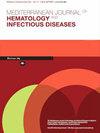HAPLOIDENTICAL TRANSPLANT WITH POST-TRANSPLANT CYCLOPHOSPHAMIDE FOR ACUTE MYELOID LEUKAEMIA AND MYELODYSPLASTIC SYNDROMES PATIENTS: THE ROLE OF PREVIOUS LINES OF THERAPY.
IF 2
4区 医学
Q3 HEMATOLOGY
Mediterranean Journal of Hematology and Infectious Diseases
Pub Date : 2024-01-01
DOI:10.4084/mjhid.2024.002
引用次数: 0
Abstract
Background: Allogeneic haematopoietic stem-cell transplant is a potentially curative option for high-risk acute myeloid leukaemia (AML) and myelodysplastic syndrome (MDS) patients. Post-transplant cyclophosphamide administration allows for selection of haploidentical donors in patients who are eligible for the procedure, but do not have a fully matched donor, since it can overcome the HLA barrier. There is still an active debate on whether intensification of the conditioning regimen is necessary with haploidentical donors when peripheral blood stem cells are used as the source of the graft. Herein we report our decennial experience of haploidentical stem-cell transplant using peripheral blood stem cells at King’s College Hospital. Objectives: The primary objective was to evaluate overall survival (OS) for patients with less than two previous lines of therapy. Secondary objectives were total OS, OS according to cytomegalovirus (CMV) reactivation, incidence of transplant-related mortality (TRM), graft-versus-host disease (GVHD) and GVHD-relapse-free survival (GRFS). Results: One-year and three-year total OS were 62% and 43%, respectively, with a median OS of 22 months. One-year and three-year OS for patients with ≤2 and in patients with >2 previous lines of therapy were 72% and 55%, and 60% and 22%, respectively (p-value=0.04). The median OS in patients with >2 previous lines of therapy and ≤2 lines of therapy was 16 and 49 months, respectively. Cumulative incidence (CI) of relapse was 25% with a median time to relapse of 5 months (range 1 – 38 months). Conclusions: Haploidentical haematopoietic stem-cell transplant is potentially curative in chemo-sensitive AML and MDS and offers a high rate of prolonged remission. Our cohort further confirms the role of consolidative haploidentical transplant in patients in complete remission and highlights that patients with heavily pre-treated disease may not benefit from this strategy.对急性髓性白血病和骨髓增生异常综合征患者进行单倍体移植和移植后环磷酰胺治疗:前几种疗法的作用。
背景:同种异体造血干细胞移植是高危急性髓性白血病(AML)和骨髓增生异常综合征(MDS)患者的潜在治愈选择。移植后服用环磷酰胺可以克服HLA障碍,为符合移植条件但没有完全匹配供体的患者选择单倍体供体。在使用外周血干细胞作为移植物来源时,是否有必要对单倍体捐献者加强调理方案,目前仍存在激烈的争论。 我们在此报告国王学院医院十年来使用外周血干细胞进行单倍体干细胞移植的经验。 目标:首要目标是评估既往接受过两种以下治疗的患者的总生存率(OS)。次要目标是总存活率、巨细胞病毒(CMV)再活化的存活率、移植相关死亡率(TRM)、移植物抗宿主疾病(GVHD)和GVHD-无复发存活率(GRFS)。 结果显示一年和三年总OS分别为62%和43%,中位OS为22个月。既往接受过≤2次和>2次治疗的患者的一年和三年OS分别为72%和55%,以及60%和22%(P值=0.04)。既往接受过>2种疗法和≤2种疗法的患者的中位OS分别为16个月和49个月。复发累积发生率(CI)为25%,中位复发时间为5个月(1-38个月)。 结论对于化疗敏感的急性髓细胞性白血病和骨髓增生异常综合症,单倍体造血干细胞移植具有潜在的治愈性,并能提供较高的长期缓解率。我们的队列进一步证实了完全缓解患者进行巩固性单倍体造血干细胞移植的作用,并强调预处理严重的患者可能无法从这一策略中获益。
本文章由计算机程序翻译,如有差异,请以英文原文为准。
求助全文
约1分钟内获得全文
求助全文
来源期刊

Mediterranean Journal of Hematology and Infectious Diseases
Medicine-Hematology
CiteScore
4.20
自引率
6.20%
发文量
113
审稿时长
12 weeks
期刊介绍:
Reciprocal interdependence between infectious and hematologic diseases (malignant and non-malignant) is well known. This relationship is particularly evident in Mediterranean countries. Parasitosis as Malaria, Leishmaniosis, B Hookworms, Teniasis, very common in the southeast Mediterranean area, infect about a billion people and manifest prevalently with anemia so that they are usually diagnosed mostly by experienced hematologist on blood or bone marrow smear. On the other hand, infections are also a significant problem in patients affected by hematological malignancies. The blood is the primary vector of HIV infection, which otherwise manifest with symptoms related to a reduction in T lymphocytes. In turn, infections can favor the insurgency of hematological malignancies. The causative relationship between Epstein-Barr virus infection, Helicobacter pylori, hepatitis C virus, HIV and lymphoproliferative diseases is well known.
 求助内容:
求助内容: 应助结果提醒方式:
应助结果提醒方式:


